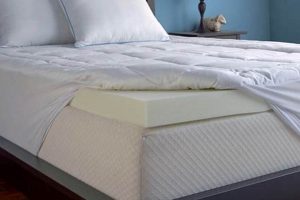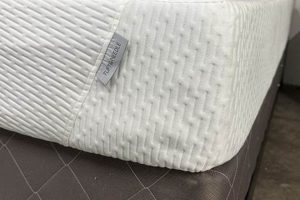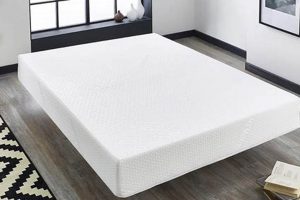The duration required for a memory foam mattress to reach its full dimensions after unboxing varies, influenced by factors such as the mattress’s density, ambient temperature, and compression method used during packaging. This expansion process, also referred to as off-gassing in some contexts, typically involves the mattress regaining its intended shape and firmness. For instance, a high-density memory foam mattress stored in a cold warehouse may require more time to fully expand compared to a low-density mattress unpacked in a warm room.
Understanding the timeframe for this process is crucial for consumers to plan accordingly and ensure optimal comfort and support. A complete expansion allows the memory foam to properly conform to the body, providing the pressure relief and spinal alignment it’s designed to offer. Historically, inconsistencies in manufacturing and packaging techniques led to unpredictable expansion times, but advancements in technology have allowed for more standardized and predictable outcomes.
The subsequent sections will delve into the specific factors that impact this timeframe, provide detailed guidance on accelerating the expansion process where possible, and outline potential issues that may arise if the mattress is used prematurely before full expansion has occurred.
Optimizing Mattress Expansion
Maximizing the potential of a newly unboxed memory foam mattress necessitates understanding the factors influencing its expansion. The following tips detail methods to promote complete and timely inflation.
Tip 1: Unpack Immediately: Prolonged compression hinders proper expansion. Removing the mattress from its packaging shortly after delivery is recommended.
Tip 2: Maintain Adequate Room Temperature: Memory foam responds to warmth. A room temperature between 70-75F (21-24C) will facilitate quicker expansion.
Tip 3: Provide Adequate Ventilation: Air circulation assists in the release of volatile organic compounds (VOCs) associated with the manufacturing process. Opening windows and using fans is advised.
Tip 4: Allow Ample Time: Despite best efforts, complete expansion may require up to 72 hours. Refrain from using the mattress until it has fully reached its intended dimensions.
Tip 5: Rotate the Mattress: Periodically rotating the mattress during the initial expansion period may aid in even inflation across the entire surface.
Tip 6: Inspect for Uniform Expansion: Closely examine the mattress for any areas that remain compressed or uneven after the recommended expansion time. Contact the manufacturer if discrepancies persist.
Adhering to these recommendations will contribute to a more successful and timely expansion, ensuring the mattress delivers its intended level of comfort and support.
The subsequent section will address potential issues that may arise and provide troubleshooting advice for common expansion-related concerns.
1. Initial Unboxing
The initial unboxing of a memory foam mattress marks the starting point of its expansion process, directly influencing the overall timeframe required for the mattress to reach its intended dimensions and firmness. Delaying this crucial step can adversely affect the subsequent expansion and potentially compromise the mattress’s performance.
- Immediate Release of Compression
Prompt removal from the compressed packaging allows the memory foam to begin its recovery immediately. The longer a mattress remains compressed, the more time it will require to fully expand, as the foam’s internal structure has been constrained for an extended duration. For example, a mattress left in its rolled state for several weeks may experience a significantly prolonged expansion compared to one unboxed within days of delivery.
- Exposure to Ambient Conditions
Unboxing the mattress exposes it to the surrounding environment, including temperature and humidity, both of which play a crucial role in the expansion rate. A warm, well-ventilated room promotes faster expansion as the foam becomes more pliable. Conversely, a cold or damp environment can impede the process, delaying the mattress’s recovery and potentially affecting its overall comfort. A mattress unboxed in a heated room during winter will generally expand more quickly than one unboxed in an unheated garage.
- Visual Assessment for Immediate Issues
The unboxing process provides an opportunity to visually inspect the mattress for any manufacturing defects or damage sustained during shipping. Identifying issues such as tears, indentations, or uneven compression early allows for timely intervention and prevents further complications. For instance, discovering a large tear during unboxing would warrant contacting the manufacturer immediately, rather than waiting for the mattress to fully expand and potentially exacerbate the problem.
- Facilitation of Off-Gassing
The unboxing stage initiates the release of volatile organic compounds (VOCs), a process often referred to as off-gassing. While generally harmless, these compounds can emit a noticeable odor, particularly during the initial expansion phase. Prompt unboxing and adequate ventilation facilitate the dissipation of these odors, contributing to a more comfortable and healthy sleep environment. A mattress unboxed and left to air out in a well-ventilated room will typically experience a faster reduction in off-gassing odors compared to one left in its packaging.
Therefore, the actions taken during the initial unboxing process have a direct and measurable impact on the subsequent expansion of a memory foam mattress. Timely removal from packaging, exposure to favorable environmental conditions, early detection of potential issues, and facilitation of off-gassing collectively contribute to a more efficient and successful expansion, ultimately influencing the overall performance and longevity of the mattress.
2. Foam Density
Foam density, measured in pounds per cubic foot (lbs/ft), directly influences the duration required for a memory foam mattress to achieve full expansion. Higher density foams possess a more compact cellular structure, resulting in a slower rate of expansion compared to lower density counterparts. The increased material per unit volume impedes the rapid influx of air necessary for the foam to regain its intended shape after compression. For example, a memory foam mattress with a density of 5 lbs/ft may require 72 hours or more to fully expand, whereas a mattress with a density of 3 lbs/ft may achieve complete expansion within 24-48 hours. This difference in expansion time is attributable to the inherent resistance to airflow within the denser material.
Understanding the relationship between foam density and expansion time is critic
al for both manufacturers and consumers. Manufacturers can leverage this knowledge to optimize compression techniques and packaging methods, potentially reducing the time required for expansion. Consumers can use this information to manage their expectations and plan accordingly, ensuring they allocate sufficient time for the mattress to fully expand before use. A customer receiving a high-density memory foam mattress should anticipate a longer expansion period and avoid premature use, as this could compromise the mattress’s long-term performance and comfort. Furthermore, awareness of density-related expansion variations allows consumers to make informed purchase decisions based on their individual needs and time constraints.
In summary, foam density serves as a primary determinant in the time required for a memory foam mattress to fully expand. The higher the density, the slower the expansion rate due to the increased resistance to airflow within the material’s structure. This understanding is essential for optimizing manufacturing processes, managing consumer expectations, and making informed purchase decisions. While other factors also play a role, density remains a key variable in predicting and influencing the expansion timeline of memory foam mattresses.
3. Ambient Temperature
Ambient temperature exerts a significant influence on the timeframe required for a memory foam mattress to fully expand after unboxing. Memory foam’s viscoelastic properties are temperature-sensitive, causing the material to soften and become more pliable at higher temperatures and stiffen at lower temperatures. Consequently, a mattress exposed to warmer ambient conditions will typically expand more rapidly compared to one situated in a cooler environment. For instance, a memory foam mattress unboxed in a room maintained at 75F (24C) may achieve full expansion within 48 hours, while the same mattress unboxed in a 60F (16C) room could require upwards of 72 hours or more. The reduced kinetic energy at lower temperatures inhibits the foam’s ability to regain its original shape, thereby prolonging the expansion process.
The practical implications of this temperature dependence are substantial. Consumers unpacking a memory foam mattress during colder months, or in a climate-controlled environment set to a low temperature, should anticipate a longer expansion period. Conversely, during warmer months, or in rooms with adequate heating, the expansion process may be accelerated. Manufacturers and retailers should also consider ambient temperature when providing guidance on expected expansion times, accounting for potential variations based on geographical location and seasonal changes. Retailers often include a disclaimer regarding expansion times, but rarely explicitly state that cooler temperatures will add to the wait time. Furthermore, storage conditions prior to unboxing also play a role; mattresses stored in unheated warehouses during winter may require even longer expansion periods once brought into a warmer environment.
In conclusion, ambient temperature is a critical factor governing the rate at which memory foam mattresses expand. Its influence stems from the inherent temperature sensitivity of memory foam’s viscoelastic properties. Understanding this relationship enables consumers to optimize their unpacking process, anticipate potential delays, and adjust their expectations accordingly. Manufacturers and retailers can leverage this knowledge to provide more accurate guidance and improve customer satisfaction. Addressing challenges related to inconsistent temperature control throughout the supply chain can further enhance the predictability and efficiency of the mattress expansion process.
4. Air Circulation
Air circulation plays a crucial role in influencing the rate at which a memory foam mattress expands after compression. The off-gassing process, inherent to new memory foam, involves the release of volatile organic compounds (VOCs) trapped within the foam’s structure. Adequate air circulation facilitates the dissipation of these VOCs, preventing their accumulation and potentially hastening the expansion process. Stagnant air can create a microenvironment around the mattress that concentrates these compounds, slowing down the overall expansion and prolonging the duration for the mattress to achieve its intended firmness and dimensions. As an example, a mattress unboxed in a confined, poorly ventilated room may take significantly longer to fully expand compared to an identical mattress unboxed in a spacious, well-ventilated area.
Beyond off-gassing, air circulation also affects the temperature equilibrium of the memory foam. Memory foam responds to temperature, becoming more pliable and expanding more readily in warmer conditions. Adequate air circulation helps to distribute heat evenly across the mattress surface, preventing localized pockets of cold air that could impede expansion in specific areas. The absence of proper ventilation can create temperature gradients within the mattress, leading to uneven expansion and potentially affecting the overall comfort and support provided. Opening windows, using fans, or employing air purifiers equipped with circulation features are effective methods for enhancing air movement around the mattress during the expansion phase.
In summary, air circulation is a significant factor governing the expansion rate of memory foam mattresses. Its influence stems from its ability to facilitate the dissipation of VOCs and promote temperature uniformity. While temperature and foam density are primary factors, optimizing air circulation represents a practical and readily implementable strategy for accelerating the expansion process. The challenge lies in informing consumers about the importance of ventilation and providing clear guidance on effective methods for ensuring adequate air circulation during the crucial initial expansion period.
5. Mattress Thickness
Mattress thickness, representing the vertical dimension of the mattress, is intrinsically linked to the duration required for complete expansion of memory foam mattresses. The volume of memory foam material directly influences the time needed for the mattress to fully recover its intended shape and firmness following compression during packaging and shipping.
- Increased Material Volume
A thicker mattress inherently contains a greater volume of memory foam. This larger volume requires more time for air to permeate throughout the material, allowing the foam cells to fully expand. The expansion process relies on the influx of air to restore the foam’s intended density and support characteristics. Consequently, a 14-inch mattress will generally necessitate a longer expansion timeframe than an 8-inch mattress comprised of similar materials and densities. This is not a linear relationship, but generally, more material translates to a longer process.
- Compression Depth and Rate
Thicker mattresses are often subjected to greater compression during packaging to reduce their volume for shipping. The extent of this compression directly affects the time needed for the foam to rebound. Deeper compression necessitates a longer recovery period as the foam’s cellular structure has b
een more significantly altered. The rate at which a thick mattress expands is also influenced by the packaging materials and methods used. More rigid packaging materials may constrict expansion initially. - Heat Retention and Distribution
Thicker mattresses exhibit a greater capacity for heat retention. While a warmer environment generally facilitates faster expansion, uneven heat distribution within a thick mattress can lead to variations in expansion rates across its surface. This is especially true for multi-layered mattresses where different foam types may respond differently to temperature changes. Consequently, even in a temperature-controlled environment, thicker mattresses may require more time to achieve uniform expansion due to differential heat retention and distribution.
- Layered Construction Complexity
Many thicker memory foam mattresses incorporate multiple layers of foam with varying densities and properties. The interaction between these layers can influence the overall expansion time. Denser, lower layers may expand more slowly than less dense upper layers, creating internal stresses within the mattress. This complexity can add to the total time needed for the mattress to reach its optimal comfort and support level. Furthermore, adhesives used to bind the layers can also affect expansion.
In conclusion, mattress thickness is a significant factor affecting the duration needed for complete memory foam expansion. The increased material volume, deeper compression depths, heat retention properties, and layered construction complexity all contribute to a prolonged recovery period. Consumers and retailers must account for these factors to ensure realistic expectations and avoid premature use of the mattress before it has fully attained its intended performance characteristics.
6. Compression Method
The compression method employed during the packaging of a memory foam mattress exerts a direct influence on the timeframe required for it to fully expand post-unboxing. The degree and uniformity of compression, alongside the packaging materials utilized, serve as key determinants of the expansion rate. For instance, a mattress subjected to high-pressure rolling and subsequent vacuum sealing will generally require a longer expansion period compared to one that is simply folded and lightly compressed. This is due to the greater distortion of the foam’s cellular structure under intense compression, necessitating more time for the cells to regain their original shape and dimensions. The packaging materials themselves can also impede expansion; tightly wrapped plastic, for example, can restrict airflow and slow the recovery process. A mattress that is box compressed usually take longer to full expand.
Different compression techniques exert varying stresses on the memory foam, influencing the duration of the expansion process. Traditional rolling methods, while effective at reducing volume, can create localized areas of intense compression, leading to uneven expansion. Conversely, newer techniques involving controlled flattening and vacuum sealing aim to distribute the compression more uniformly, potentially leading to a more predictable and consistent expansion. The material and thickness of the plastic packaging further impact this process. Thicker, less permeable plastics can restrict airflow, delaying expansion. In practice, a consumer unpacking two identical mattresses subjected to different compression methods may observe significant variations in the time taken for each to reach its full size. A mattress compressed with advanced techniques may expand within 24-48 hours, while a mattress traditionally compressed may require 72 hours or longer.
In summary, the compression method is a critical factor impacting memory foam mattress expansion. The intensity and uniformity of compression, coupled with the characteristics of the packaging materials, directly influence the recovery time. Understanding this relationship enables manufacturers to optimize packaging processes, providing consumers with more accurate estimates of expansion times. Further research into innovative, less disruptive compression techniques may hold the key to minimizing expansion times and enhancing overall consumer satisfaction. The challenge lies in finding methods that balance efficient volume reduction with minimal distortion of the foam’s cellular structure, ensuring a swift and complete expansion upon unboxing.
7. Manufacturing Date
The manufacturing date of a memory foam mattress serves as a crucial indicator of the foam’s potential off-gassing period, structural integrity, and, consequently, its expansion characteristics. The age of the foam at the time of unboxing can significantly influence the time required for the mattress to fully expand.
- Initial Off-Gassing Period
Memory foam, after its creation, undergoes a process of releasing volatile organic compounds (VOCs). The majority of this off-gassing typically occurs within the initial weeks or months post-manufacturing. A mattress unboxed closer to its manufacturing date may exhibit a more pronounced off-gassing odor and potentially require a longer initial period to fully vent these compounds, indirectly affecting the perception of expansion completeness. For example, a mattress unboxed within a month of manufacture may require extensive ventilation to mitigate the VOC odor.
- Foam Degradation Over Time
Memory foam, even when properly stored, can undergo slight degradation over time. This degradation can manifest as a reduction in elasticity and an increase in brittleness. A mattress stored for an extended period post-manufacture might exhibit a slower expansion rate due to subtle structural changes within the foam matrix. For instance, a mattress stored in a warehouse for over a year might show a reduced capacity to rebound to its original shape quickly compared to a freshly manufactured one.
- Compression Set and Recovery
The time between manufacturing and unboxing can influence the degree of “compression set,” a phenomenon where the foam retains a compressed shape due to prolonged pressure. Mattresses compressed for extended periods after manufacture may exhibit a higher degree of compression set, thus requiring a longer period to fully recover their original dimensions and firmness. A mattress rolled and packaged for six months after manufacturing may require more time to achieve its intended loft compared to one packaged immediately after production.
- Material Property Changes
The chemical composition of memory foam can undergo subtle changes over time, affecting its physical properties, including its ability to expand efficiently. Additives used in the manufacturing process can degrade or interact with the foam matrix, potentially influencing its elasticity and resilience. A mattress manufactured with certain types of additives and stored for several years might demonstrate altered expansion characteristics compared to a mattress manufactured using more stable formulations and unboxed shortly after production.
Consequently, the manufacturing date provides a crucial context for understanding the anticipated expansion timeline of a memory foam mattress. While factors like foam density, temperature, and compression method play significant roles, the age of the foam itself can subtly but me
asurably influence its expansion behavior, affecting user expectations and experiences. Analyzing the manufacturing date can aid in troubleshooting unexpected expansion delays or performance issues.
Frequently Asked Questions
The following addresses common inquiries regarding the timeframe and factors influencing the expansion of memory foam mattresses after unboxing.
Question 1: How long should a memory foam mattress be left to expand before use?
The generally recommended expansion period is between 24 to 72 hours. However, high-density mattresses or those subjected to prolonged compression may require a longer duration. It is advisable to consult the manufacturer’s guidelines for specific recommendations.
Question 2: What environmental factors influence the expansion rate?
Ambient temperature is a significant factor. Warmer environments promote faster expansion, while colder temperatures may prolong the process. Adequate air circulation is also beneficial, aiding in the dissipation of volatile organic compounds and ensuring even temperature distribution.
Question 3: Can a memory foam mattress be used before it is fully expanded?
Using a mattress prematurely may compromise its long-term performance and comfort. The foam may not fully conform to the body, potentially leading to uneven support and reduced pressure relief. It is best to allow the mattress to expand completely before use.
Question 4: Is uneven expansion a cause for concern?
Minor variations in expansion are common, particularly at the edges. However, significant unevenness, such as large compressed areas or noticeable height discrepancies, may indicate a manufacturing defect or damage during shipping. In such cases, contacting the retailer or manufacturer is recommended.
Question 5: Does the density of the memory foam affect the expansion time?
Yes, higher density memory foam generally requires a longer expansion period due to its denser cellular structure. The increased material per unit volume impedes the rapid influx of air necessary for the foam to regain its intended shape.
Question 6: Can the expansion process be accelerated?
While not guaranteed, certain measures can potentially expedite the process. Ensuring a warm, well-ventilated room, removing all packaging materials immediately, and periodically rotating the mattress may assist in achieving faster expansion.
The expansion of a memory foam mattress is a multifaceted process influenced by material properties, environmental conditions, and handling practices. Adhering to recommended expansion times and optimizing environmental factors are essential for maximizing mattress performance and longevity.
The subsequent section will explore troubleshooting tips for common expansion-related issues.
How Long Memory Foam Mattress Expand
The preceding discussion has elucidated the multifaceted nature of “how long memory foam mattress expand,” outlining the key determinants governing this process. Foam density, ambient temperature, air circulation, mattress thickness, compression method, and manufacturing date each contribute to the overall expansion timeframe. Variability in these factors results in a range of expansion periods, necessitating careful consideration by both manufacturers and consumers.
A comprehensive understanding of these influences is critical for optimizing the user experience and ensuring mattress performance. Further research into advanced compression and packaging techniques, coupled with improved temperature control during storage and shipping, holds the potential to minimize expansion times and enhance consumer satisfaction. Future developments should prioritize standardized expansion guidelines and transparent communication regarding anticipated timelines based on specific mattress characteristics.







![Best Memory Foam Mattress Queen Walmart [Deals!] Organic & Natural Mattress Buyer’s Guide: Non-Toxic Sleep Solutions Best Memory Foam Mattress Queen Walmart [Deals!] | Organic & Natural Mattress Buyer’s Guide: Non-Toxic Sleep Solutions](https://mattressworldpa.com/wp-content/uploads/2025/07/th-3980-300x200.jpg)